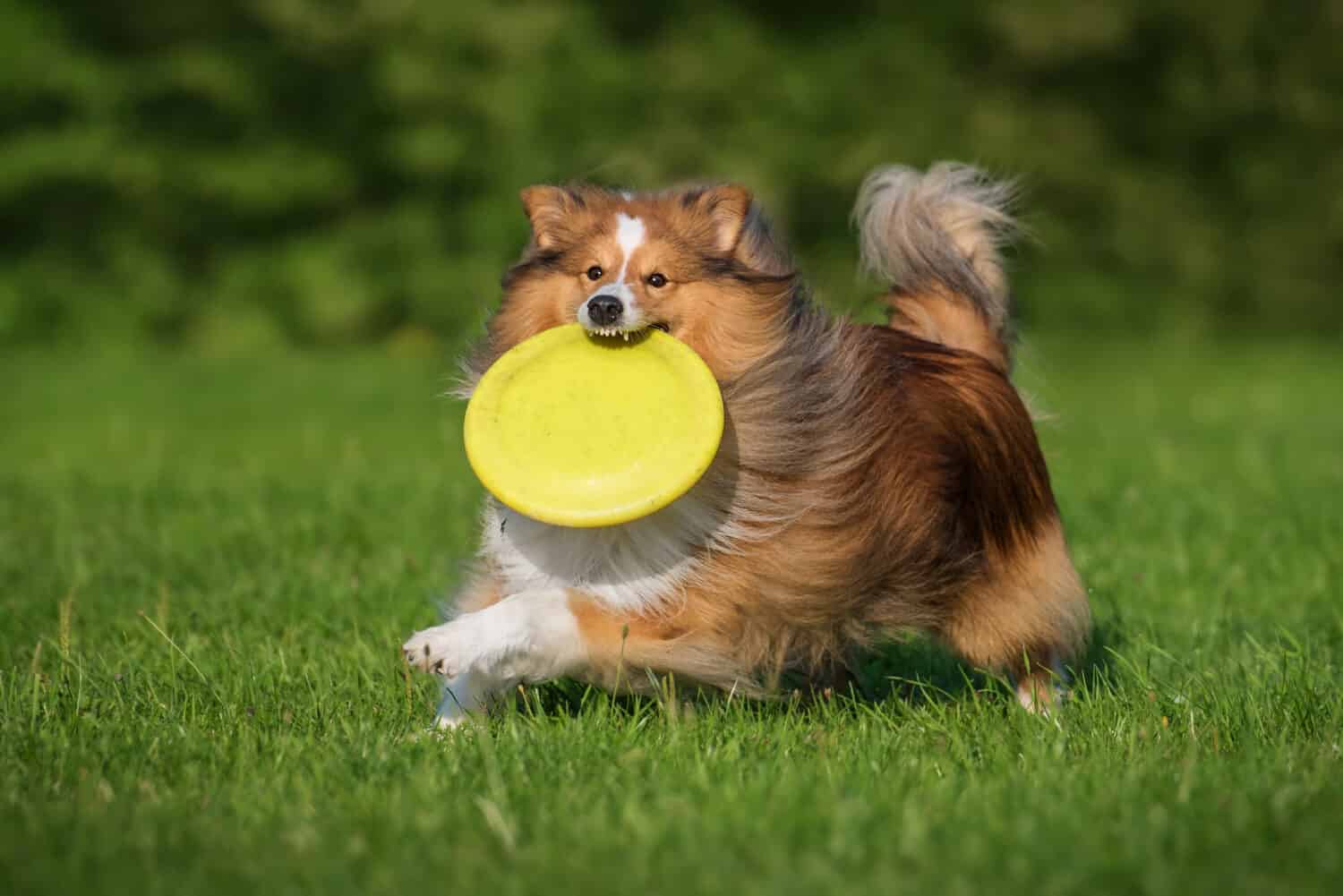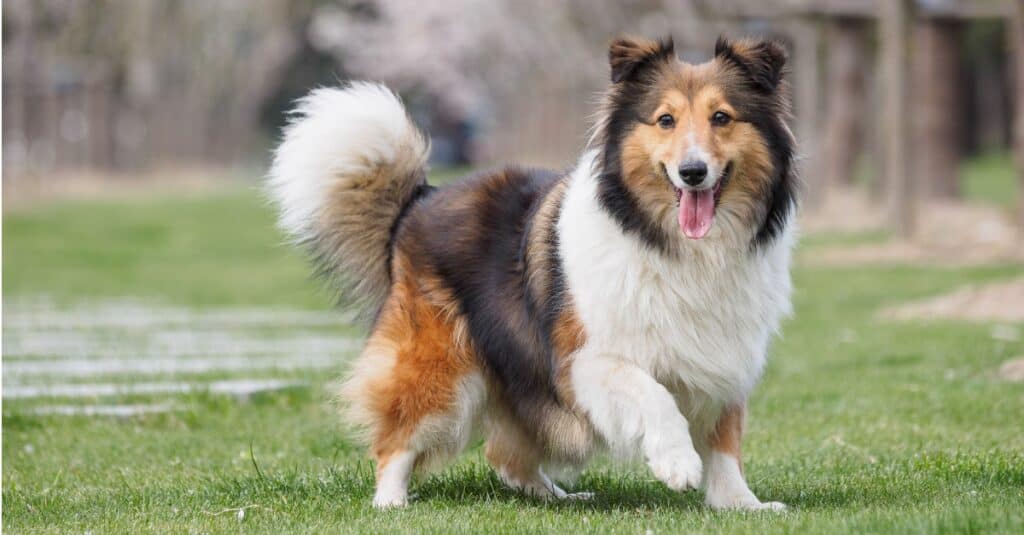If you’re preparing to bring home a Shetland sheepdog puppy, you may be wondering what to expect regarding their growth, milestones, and how to raise a content and healthy pup.
In this guide, we’ll delve into various aspects of Shetland sheepdog progression and provide tips for ethically raising a happy canine companion. Read on to learn more.
Shetland Sheepdog Progression: Breed Summary
Unlike some breeds whose history is difficult to ascertain, the story and lineage of the Shetland sheepdog, aka the Sheltie, is quite clear and traceable. These small, sturdy herding dogs originated in the 1800s from the UK’s most northern region, the Shetland Islands. There, farmers used Shelties to herd ponies, sheep, and even poultry.
In the harsh climate of the Shetland Islands, farmers selected for and obtained smaller farm animals that have fewer food requirements than their larger relatives. Hence, the area bred hardy ponies rather than horses and the small, compact Shetland sheepdog instead of their ancestor, the larger rough-coat collie.
In 1909, the English Kennel Club first recognized the Sheltie as a distinct breed from other collies.
Attributes and Standards
According to the AKC breed standards, the general appearance of a Shetland sheepdog should be “small, alert, rough-coated, longhaired…sound, agile, and sturdy”. Shelties should appear quite symmetrical with a refined head and intelligent expression.
Regarding their personality attributes, many folks find this breed to be smart, energetic, responsive, immensely affectionate to those they trust, and a bit reserved towards strangers. When discussing breed temperament, it’s important to remember that genetics may have some influence, but does not dictate the personality of an individual dog. Many other social, environmental, and health factors can also influence how a dog perceives, navigates, and responds to the world around them.

The Shetland sheepdog has the overall appearance of a miniature rough-coated collie.
©iStock.com/yanjf
Shetland Sheepdog: Growth Chart
Below, we’ll provide a growth chart estimation for the Shetland sheepdog from 2-12 months of age. Please note that genetics and diet can cause variations in how your pup grows. Since the AKC size standard is the same for female and male Shelties, we will provide only one size column for this breed.
| Age | Shetland Sheepdog Size |
|---|---|
| 2 Months | 5-9 lbs |
| 3 Months | 7-10 lbs |
| 4 Months | 9-13 lbs |
| 5 Months | 10-16 lbs |
| 6 Months | 11-19 lbs |
| 7 Months | 12-20 lbs |
| 8 Months | 13-22 lbs |
| 9 Months | 14-23 lbs |
| 10 Months | 15-25 lbs |
| 11 Months | 15-25 lbs |
| 12 Months | 15-25 lbs |
Shetland Sheepdog Progression: When Will My Sheltie Stop Growing?
On average, you can expect your Shetland sheepdog to reach full physical maturity around 10-12 months old. The accepted size range of this breed can result in some individuals reaching full maturity a little earlier than 10 months or a little later than 1 year.
By scheduling regular checkups with your vet as your puppy grows, you can ensure that your pup is properly developing. Always make sure to provide access to fresh, clean water and species-appropriate nutrition to aid in healthy development.

You can expect your Shetland sheepdog puppy to reach physical maturity around 10-12 months old.
©MirasWonderland/Shutterstock.com
How Big Will My Shetland Sheepdog Be When Fully Grown?
According to the AKC, the accepted adult size range for both female and male Shelties is 13-16 inches tall at the withers and 15-25 pounds. Note that while deviation below the low end of their height range is abnormal, it is fairly common to see purebred Shelties who are taller than the accepted official height range. Of course, diet and genetics can also cause variation from this official height and weight standard.
Shetland Sheepdog Progression: When Should My Sheltie Be Spayed or Neutered?
When considering what age to spay or neuter your Shetland sheepdog, it’s important to understand the possible risks and benefits of the procedure for this specific breed. The benefits of spaying and neutering can include reducing or eliminating certain reproductive cancers. Additionally, by spaying and neutering your dog, you avoid contributing to the crisis shelter dogs face in countries like the US where 400,000 shelter dogs are euthanized every year.
Historically, preventing or eliminating reproduction-related aggression was also touted as a benefit of altering dogs, but recent research suggests that spaying and neutering can increase fear and anxiety-related behaviors in some dogs. Older studies also correlate with this more recent research.
One recent, large-scale study tracked increased occurrences of joint disorders, cancers, and other health issues in early-spayed members of 35 breeds compared to their intact counterparts. Often, larger breed dogs are the most at risk of increased cancers and joint disorders. For Shetland sheepdogs, the study of 133 Shelties found no increased risk of cancers or joint disorders in early spaying. However, researchers noted a whopping 33% occurrence of urinary incontinence (UI) in females spayed at 1 year old. Interestingly, they noted only a 6% rate of UI for dogs spayed in the 6-11 months range. As such, we recommend that you talk with an informed veterinarian to discuss the safest age to spay your Sheltie.
When Should My Shetland Sheepdog Be Potty Trained?
You can begin potty training your Shetland sheepdog puppy as soon as you bring them home. Make sure to stock up on lots of puppy pads unless you plan on taking them out throughout the night. Please refrain from keeping them in a small space at night in an attempt to prevent them from eliminating. The amount of time that a puppy can hold their bowels and bladder is a biological reality correlating with their age.
A general rule of thumb is that your puppy can hold it for as many hours as they are months old. So, a two-month-old puppy can wait up to about 2 hours before having to eliminate again. Putting them in a confined space won’t change this biological reality, but it can certainly make them feel uncomfortable and unsafe. Instead, just make sure to take them out before they hit the max amount of time they can hold it and place a couple of puppy pads near their sleeping area at night to give them a comfortable, appropriate place to eliminate.
You’ll also have increased success if you take them outside a few minutes after their meals and after they drink lots of water. Make sure to give them plenty of praise, treats, and affection when they go to the bathroom in appropriate places. If they have an accident, please refrain from using punishment as this will only damage your relationship and frighten your puppy. You may even find that your puppy begins to hide where they go to the bathroom inside because the scolding didn’t teach them where you’d like them to go, but it did teach them that you are unsafe to use the bathroom around.
Shetland Sheepdog Progression: When Should My Sheltie Stop Eating Puppy Food?
As a rough rule of thumb, you can transition your Sheltie to adult food when they’re between 10-12 months old. By switching at this time, you are allowing your pup to reach full skeletal maturity before transitioning them to less calorically-dense adult food. If you stop feeding puppy food too early, you can risk compromising the healthy development of your pup.
Typically, puppies should ideally eat 3-4 times per day. Once you switch your Sheltie over to adult food, you can decrease feeding to two times per day if that schedule suits you. Some folks also continue feeding lunch to their dogs as part of food-based enrichment.

At around 10-12 months, you can begin switching your Sheltie pup to adult food.
©Filmbildfabrik/Shutterstock.com
When Will My Shetland Sheepdog Start Losing Teeth?
At about 12 weeks old, your Sheltie puppy should begin losing their set of 28 puppy teeth. In exchange, a set of 42 permanent teeth will begin erupting from their gums. By the time they are 6-7 months old, they should have their full set of adult teeth.
Between this 3-7 month period will likely be seeking items to chew to relieve gum discomfort. It’s crucial to provide them with a variety of safe chewing items such as various textured puppy toys and frozen carrots. You may need to gate off certain areas of your house or come up with creative storage solutions to prevent unwanted items from being chewed. Containing your pup in a crate to prevent chewing is not recommended as extended confinement in small spaces can create long-term emotional and mental suffering. If your pup enjoys den-like spaces, you can always set up a crate with the door open to allow choice.
If you find your pup chewing on something inappropriate, make sure to trade the item for something appropriate of equal or better value (to your dog). By trading, rather than just taking away, you are strengthening the relationship with your dog and showing your pup that you are safe to give items to. If you only take away things they are chewing on, your pup will likely develop habitual resource-guarding behaviors and may even swallow unsafe items to keep you from taking them away.
Shetland Sheepdog Progression: When Should I Start Training My Sheltie?
When your Sheltie is 8 weeks old, you can begin the fun, engaging training sessions that are only a couple of minutes long. You’ll want to prioritize rewarding education with these sessions and make sure that your puppy enjoys them. Training shouldn’t be about obedience or control, but rather, teaching cues to our pup that help them more safely navigate a human-dominated world.
In recent years, the focus on raising puppies is starting to (thankfully) shift from obedience and control to facilitating a supportive, secure attachment bond that supports the ability of dogs to socially process and engage in various environments throughout their lives.
Part of supporting your Sheltie puppy in learning how to socially process our world is through exposing them to positive experiences during their critical early socialization period. From 3-12 weeks of age, your puppy’s brain is primed for building millions of synaptic connections to rapidly learn about the world.
During this stage, your puppy is particularly receptive to being curious and learning about the world around them. Gently and supportively introducing them to one new, positive experience every day during this time frame is a great way to facilitate the development of a well-rounded adult dog. These new experiences can include new textures, sounds, smells, tastes, sights, places, and social engagements.

Introducing your Shetland sheepdog puppy to positive experiences of new textures, sights, sounds, tastes, and smells will help them become a well-rounded adult.
©Lisjatina/Shutterstock.com
What Cues Should I Teach My Shetland Sheepdog First?
Whether you are planning on teaching herding with your Sheltie or are raising a family companion, it’s crucial to teach your pup a solid recall. Teaching your pup to reliably recall helps keep them safe throughout their life and expands the options of where you can go together.
While there are several ways one could motivate their dog to return when called, the best method is built upon a solid, supportive relationship in which your pup innately wants to be with you. You can also supplement this bond with positive reinforcement by providing rewards that are motivating for your specific dog to increase consistent recalls, especially in distracting, dynamic environments.
Additionally, because your young Sheltie may have difficulty settling in chaotic environments, it’s a good idea to teach them a settle cue from a young age. One way to do this is to set up a comfy mat and teach your pup to stay or “place” on this mat when you bring it out. You should create this mat as a wonderful place for them to hang out where they receive lots of treats and chews. You begin teaching this skill in a distraction-free environment and slowly bring in more distractions and increase the duration as you proof the skill. Eventually, you can bring this mat out at cafes, when hyper grandkids come over, etc., and give your pup a positive, comfy place to settle.
If you find that your pup has a lot of difficulties settling on the mat, then it’s best to think about what species and breed-specific needs they may have that aren’t being met, or if the bar is set too high, rather than just focusing on trying to train harder at the mat skill.
Shetland Sheepdog Progression: When Will My Sheltie Calm Down?
Your Sheltie pup should reach social maturity by 2-3 years old, but this doesn’t necessarily mean they’ll feel calm and collected. As mentioned above, if you’re pup doesn’t have their species and breed-specific needs met, they may have a difficult time settling down, whether that’s on a mat or overall in their daily life.
For Shelties, you may need to incorporate plenty of physically active enrichment into their lives. Providing enough mental, social, and physical enrichment that is novel and engaging for your pup is crucial to allowing them to feel content and calm. Without this, they may exhibit hyperexcitability and anxious behaviors.

Having enough access to play is crucial for your Sheltie to be able to feel calm and content in their life.
©Rita_Kochmarjova/Shutterstock.com
Common Health Issues Your Shetland Sheepdog Might Experience
Purebred Shetland sheepdogs face an increased risk of developing or being born with the following health conditions:
- Hip dysplasia
- Thyroid conditions
- Skin conditions
- Epilepsy
- Optical diseases
- Gallbladder mucoceles (excess accumulation of gallbladder mucus or bile)
If you notice that your Sheltie pup is displaying clinical signs of a health issue or has suddenly changed its baseline behavior, it’s important to set up a visit with your veterinarian.
Picture of Shetland Sheepdog Puppies

Two cute-as-pie Sheltie puppies gaze into the camera.
©Tatyana Pronina/Shutterstock.com
Picture of Shetland Sheepdog at 6 Months

A 6-month-old Shetland sheepdog tends to have a less full coat than adults.
©Eric Isselee/Shutterstock.com
Picture of an Adult Shetland Sheepdog

An adult tri-colored Shetland sheepdog plays in a field.
©iStock.com/yanjf
The photo featured at the top of this post is © Lisjatina/Shutterstock.com
Ready to discover the top 10 cutest dog breeds in the entire world?
How about the fastest dogs, the largest dogs and those that are -- quite frankly -- just the kindest dogs on the planet? Each day, AZ Animals sends out lists just like this to our thousands of email subscribers. And the best part? It's FREE. Join today by entering your email below.
Thank you for reading! Have some feedback for us? Contact the AZ Animals editorial team.






